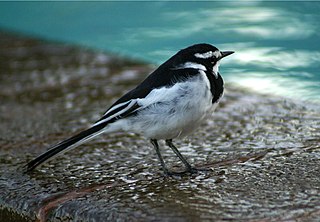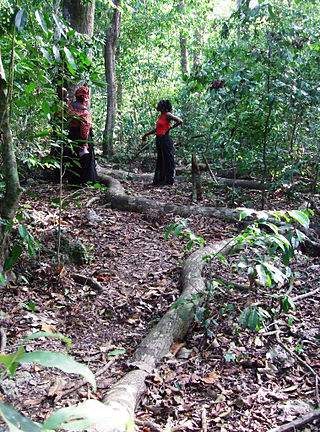Related Research Articles

Mijikenda are a group of nine related Bantu ethnic groups inhabiting the coast of Kenya, between the Sabaki and the Umba rivers, in an area stretching from the border with Tanzania in the south to the border near Somalia in the north. Archaeologist Chapuruka Kusimba contends that the Mijikenda formerly resided in coastal cities, but later settled in Kenya's hinterlands to avoid submission to dominant Portuguese forces that were then in control. Historically, these Mijikenda ethnic groups have been called the Nyika or Nika by outsiders. It is a derogatory term meaning "bush people."
Kaya may refer to:

Kilifi is a town on the coast of Kenya, 56 kilometres (35 mi) northeast by road of Mombasa. The town lies on the Kilifi Creek and sits on the estuary of the Goshi River. Kilifi is capital of the Kilifi County and has a population of 122,899.

The Giriama are one of the nine ethnic groups that make up the Mijikenda.
Kenya is a multilingual country.
Takaungu is a historic Swahili town located on the Kenyan Coast between Mombasa and Malindi, in Kilifi County.
The Pokomo people are a Bantu ethnic group of southeastern Kenya. Their population in Kenya was 112,075 in 2019. They are a distinct ethnic group with their own sub-clans/tribes. Despite their proximity, they are not of the nearby Mijikenda people. They are predominantly agriculturalists and both freshwater and ocean fishermen living along the Tana River in Tana River County. They speak the Pokomo language, which is similar to Swahili.

Diani Beach is a major beach on the Indian Ocean coast of Kenya. It is located 30 kilometres (19 mi) south of Mombasa, in Kwale County.

The Chonyi, also referred to as Achonyi, are one of the smaller tribes of the Mijikenda on the coast of Kenya.

The Digo are a Bantu ethnic and linguistic group based near the Indian Ocean coast between Mombasa in southern Kenya and northern Tanga in Tanzania. In 1994 the Digo population was estimated to total 305,000, with 217,000 ethnic Digo living in Kenya and 88,000 in Tanzania. Digo people, nearly all Muslims, speak the Digo language, called Chidigo by speakers, a Bantu language.

In many parts of sub-Saharan Africa, the use of music is not limited to entertainment: it serves a purpose to the local community and helps in the conduct of daily routines. Traditional African music supplies appropriate music and dance for work and for religious ceremonies of birth, naming, rites of passage, marriage and funerals. The beats and sounds of the drum are used in communication as well as in cultural expression.

Kilifi County was formed in 2010 as a result of a merger of Kilifi District and Malindi District, Kenya. Its capital is Kilifi and its largest town is Malindi. Kilifi county is one of the five counties that make up the Kenyan Coast. The county has a population of 1,453,787 people following the 2019 census which covers an area of 12,245.90 km2 (4,728.17 sq mi).

The Jibana or Dzihana people are an ethnic group from Kenya and a subgroup of the Mijikenda. There are 38,466 of them, all speakers of Kijibana. The Jibana community lives in Kaloleni subcounty of Kilifi county. Like the other Mijikenda communities, they have an organized clans which trace their origin from the ancient ancestors.
Mnyazi wa Menza, also known as Mekatilili Wa Menza or Mekatilili (1860s-1924) was a Kenyan independence activist who led the Giriama people against the colonial administration of Kenya between 1912 and 1915.

The Taita people are an ethnic group in Kenya's Taita-Taveta County. They speak Kidawida or Kitaita, which belongs to the Bantu language family. The West-Bantu migrated to the Taita-Taveta County around 1000-1300.

Kigango is a carved wooden memorial statue erected by the Mijikenda peoples of the southeastern Kenya coast. The vigango, which can be stylized, abstracted human-form effigies and are placed vertically rising out of the earth, honor a dead member of the secret Gohu society, or the "Society of the Blessed".
Mwanzele is a dance style originally performed during funerals by the Mijikenda tribe of the Coast Province of Kenya.

A kaya is a sacred site of the Mijikenda people in the former Coast Province of Kenya. Often located within sacred forests, a kaya is considered to be an intrinsic source of ritual power and the origin of cultural identity; it is also a place of prayer for members of the Mijikenda ethnic group. The settlement, ritual centre, and fortified enclosure associated with the forest are also part of the kaya. In the present day, the kaya is also referred to as a traditional organizational unit of the Mijikenda. Eleven of the approximately 60 separate makaya have been grouped together and inscribed as the Sacred Mijikenda Kaya Forests, a UNESCO World Heritage Site.

African divination is divination practiced by cultures of Africa.
Kaya Mudzi Muvya is a coastal lowland dry deciduous forest in Kilifi County of southern Kenya. It became a World Heritage Site in 2008. A large portion of the forest is an area protected by the Kenya Forest Service under The Forests Act of 2005, and as a national monument under the Antiquities and Monuments Act Cap 215. The forest is sacred to the local Mijikenda people, known as the Rabai. The forest has suffered deprevation over the past hundred years.
References
- ↑ Parkinson, Tom; Phillips, Matt; Gourlay, Will (2006). Kenya. Lonely Planet. pp. 204–. ISBN 978-1-74059-743-2.
- ↑ Trillo, Richard (1 May 2013). The Rough Guide to Kenya. Rough Guides. pp. 551–. ISBN 978-1-4093-3018-9.
- ↑ Parkin, David (16 March 2006). The Sacred Void: Spatial Images of Work and Ritual Among the Giriama of Kenya. Cambridge University Press. pp. 37–. ISBN 978-0-521-02498-3.
- ↑ Carmichael, David L.; Hubert, Jane; Reeves, Brian; Audhild Schanche (15 April 2013). Sacred Sites, Sacred Places. Routledge. pp. 134–. ISBN 978-1-135-63320-2.